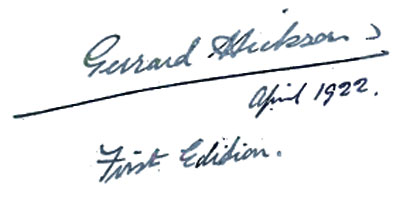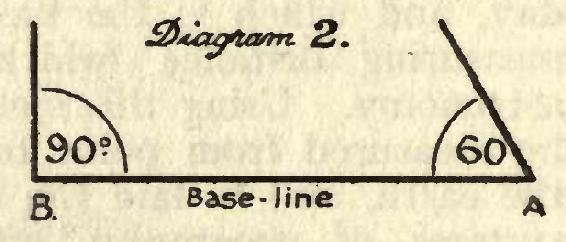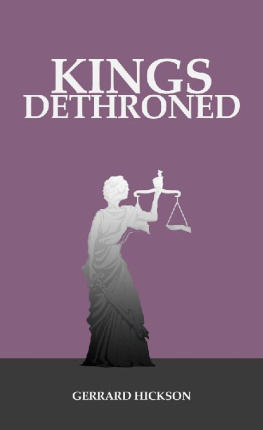Gerrard Hickson - Kings Dethroned
Here you can read online Gerrard Hickson - Kings Dethroned full text of the book (entire story) in english for free. Download pdf and epub, get meaning, cover and reviews about this ebook. year: 2017, publisher: FramSteget Bokförlag, genre: Science fiction. Description of the work, (preface) as well as reviews are available. Best literature library LitArk.com created for fans of good reading and offers a wide selection of genres:
Romance novel
Science fiction
Adventure
Detective
Science
History
Home and family
Prose
Art
Politics
Computer
Non-fiction
Religion
Business
Children
Humor
Choose a favorite category and find really read worthwhile books. Enjoy immersion in the world of imagination, feel the emotions of the characters or learn something new for yourself, make an fascinating discovery.
- Book:Kings Dethroned
- Author:
- Publisher:FramSteget Bokförlag
- Genre:
- Year:2017
- Rating:5 / 5
- Favourites:Add to favourites
- Your mark:
- 100
- 1
- 2
- 3
- 4
- 5
Kings Dethroned: summary, description and annotation
We offer to read an annotation, description, summary or preface (depends on what the author of the book "Kings Dethroned" wrote himself). If you haven't found the necessary information about the book — write in the comments, we will try to find it.
Kings Dethroned — read online for free the complete book (whole text) full work
Below is the text of the book, divided by pages. System saving the place of the last page read, allows you to conveniently read the book "Kings Dethroned" online for free, without having to search again every time where you left off. Put a bookmark, and you can go to the page where you finished reading at any time.
Font size:
Interval:
Bookmark:
KINGS DETHRONED
A history of the evolution of astronomy from the time of the Roman Empire up to the present day; showing it to be an amazing series of blunders founded upon an error made in the second century B.C.
By
GERRARD HICKSON
First published by THE HICKSONIA PUBLISHING CO.
2 Bride Court, Fleet Street, London, E.C4.
and
21 Newberry Avenue, Stapleton, Staten Island,
New York, U.S.A.
1922
The diagrams in this book, with the exception of Nos. i,2, 7, 8 and 10, are the original work of the author, registered, and may not be reproduced for sale, lectures or motion pictures without his permission.
* * *
FramSteget Bokfrlag
Omslag: FramSteget
ISBN 978-91-7581-096-6
CONTENT
In the year 1907 the author made a remarkable discovery which convinced him that the sun was very much nearer to the earth than was generally supposed. The fact he had discovered was demonstrated beyond all doubt, so that he was compelled to believe that - however improbable it might seem astronomers had made a mistake when they estimated the distance of the sun to be ninety-three millions of miles.
He then proceeded to examine the means by which the sun's distance had been computed, and found an astounding error in the Diurnal Method of Measurement by Parallax, which had been invented by Dr. Halley in the early part of the 18th century, and which was used by Sir David Gill in measuring the distance to the planet Mars in 1877; from which he deduced his solar parallax 0/8.80".
Seeing that Sir Norman Lockyer had said that the distance to and the dimensions of everything in the firmament except the moon depends upon Sir David Gill's measurement to Mars, the author set himself the tremendous task of proving the error, tracing its consequences up to the present day, and also tracing it backwards to the source from which it sprang.
The result of that research is a most illuminating history of the evolution of astronomy from the time of the Roman Empire up to April 1922; which is now placed in the hands of the people in "Kings Dethroned".
The author has taken the unusual course of submitting these new and startling theories for the consideration of the general public because the responsible scientific societies in London, Washington and Paris, failed to deal with the detailed accounts of the work which he forwarded to them in the Spring of 1920. He believes that every newly-discovered truth belongs to the whole of mankind, wherefore, if those whose business it is to consider his work fail in their duty he does not hesitate to bring it himself direct to the people, assured of their goodwill and fair judgment.
Astronomy has ever been regarded as a study only for the few, but now all its strange terms and theories have been explained in the most lucid manner in "Kings Dethroned", so that everyone who reads will acquire a comprehensive knowledge of the science.
The author takes this opportunity of assuring the reader that none esteems more highly than he, himself, the illustrious pioneers who devoted their genius to the building of astronomy, for he feels that even while pointing out their errors he is but carrying on their work, striving, labouring even as they did, for the same good cause of progress in the interests of all. On the other hand, he thinks that astronomers living at the present time might have used to better purpose the greater advantages which this century provides, and done all that he himself has done by fearless reasoning, devoted labour; and earnest seeking after truth.
G. H.

THREE thousand years ago men believed the earth was supported on gigantic pillars. The sun rose in the east every morning, passed overhead, and sank in the west every evening; then it was supposed to pass between the pillars under the earth during the night, to re-appear in the east again next morning.
This idea of the universe was upset by Pythagoras some five hundred years before the birth of Christ, when he began to teach that the earth was round like a ball, with the sun going round it daily from east to west; and this theory was already about four hundred years old when Hipparchus, the great Greek scientist, took it up and developed it in the second century, B.C.
Hipparchus may be ranked among the score or so of the greatest scientists who have ever lived. He was the inventor of the system of measuring the distance to far off objects by triangulation, or trigonometry, which is used by our surveyors at the present day, and which is the basis of all the methods of measuring distance which are used in modern astronomy. Using this method of his own invention, he measured from point to point on the surface of the earth, and so laid the foundation of our present systems of geography, scientific map-making and navigation.
It would be well for those who are disposed to under-estimate the value of new ideas to consider how much the world owes to the genius of Hipparchus, and to try to conceive how we could have made progress as we know it without him.

The principles of triangulation are very simple, but because it will be necessary as I proceed to show how modern astronomers have departed from them, I will explain them in detail.
Every figure made up of three connected lines is a tri or three-angle, quite regardless of the length of any of its sides. The triangle differs from all other shapes or figures in this; that the value of its three angles, when added together, admits of absolutely no variation; they always equal 180 degrees; while on the other hand all other figures contain angles of 360 degrees or more. The triangle alone contains 1 80 degrees, and no other figure can be used for measuring distance. There is no alternative whatever, and therein lies its value.
It follows, then, that if we know the value of any two of the angles in a triangle we can readily find the value of the third, by simply adding together the two known angles and subtracting the result from 180. The value of the third angle is necessarily the remainder. Thus, in our example (diagram 2) an angle of 90 degrees plus an angle of 60 equals 150, which shows that the angle at the distant object or apex of the triangle must be 30.

Now if we know the length of the base-line A B, in feet, yards, kilometres or miles, (to be ascertained by actual measurement), and also know the value of the two angles which indicate the direction of a distant object as seen from A. and B., we can readily complete the triangle and so find the length of its sides. In this way we can measure the height of a tree or church steeple from the ground level, or find the distance to a ship or lighthouse from the shore.
The reader will perceive that to obtain any measurement by triangulation it is absolutely necessary to have a base-line, and to know its length exactly. It is evident, also, that the length of the base-line must bear a reasonable proportion to the dimensions of the triangle intended; that is to say, that the greater the distance of the object under observation the longer the base-line should be in order to secure an accurate measurement.
A little reflection will now enable the reader to realize the difficulties which confronted Hipparchus when he attempted to measure the distance to the stars.
Next pageFont size:
Interval:
Bookmark:
Similar books «Kings Dethroned»
Look at similar books to Kings Dethroned. We have selected literature similar in name and meaning in the hope of providing readers with more options to find new, interesting, not yet read works.
Discussion, reviews of the book Kings Dethroned and just readers' own opinions. Leave your comments, write what you think about the work, its meaning or the main characters. Specify what exactly you liked and what you didn't like, and why you think so.










![Paul Gerrard [Paul Gerrard] - Lean Python: Learn Just Enough Python to Build Useful Tools](/uploads/posts/book/124061/thumbs/paul-gerrard-paul-gerrard-lean-python-learn.jpg)

